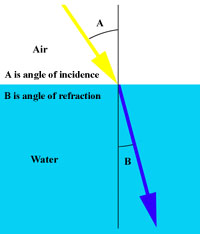 Light rays are refracted (bent) as they pass from air into water - or indeed as they emerge from water into the air. Refraction takes place because the passage of light from a rare to a dense medium causes its velocity to decrease. As the wavefront encounters the boundary between mediums, it slows and is consequently bent. This effect is easy to observe. Just sit on the edge of a lake or swimming pool and place one end of a pole in the water. The section under the water will appear to be bent. The angle of incidence, A in the diagram, is related to the angle of refraction, B in the diagram, by Snell's Law.
Light rays are refracted (bent) as they pass from air into water - or indeed as they emerge from water into the air. Refraction takes place because the passage of light from a rare to a dense medium causes its velocity to decrease. As the wavefront encounters the boundary between mediums, it slows and is consequently bent. This effect is easy to observe. Just sit on the edge of a lake or swimming pool and place one end of a pole in the water. The section under the water will appear to be bent. The angle of incidence, A in the diagram, is related to the angle of refraction, B in the diagram, by Snell's Law.
| Angle of Incidence | Angle of Refraction |
|---|---|
| 0 | 0 |
| 5 | 3.8 |
| 10 | 7.5 |
| 15 | 11.2 |
| 20 | 14.9 |
| 25 | 18.5 |
| 30 | 22.1 |
| 35 | 25.5 |
| 40 | 28.9 |
| 45 | 32.1 |
| 50 | 35.2 |
| 55 | 38.0 |
| 60 | 40.6 |
| 65 | 43.0 |
| 70 | 45.0 |
| 75 | 46.6 |
| 80 | 47.8 |
| 85 | 48.5 |
As light passes from a rare medium to a dense medium it is refracted (or bent) towards the normal, a line perpendicular to the surface. Since water is about 800 times more dense than air, the yellow ray of light in the diagram is refracted towards the normal - marked by the black line. The angle of incidence is not equal to the angle of refraction - indeed there is no simple linear relationship between the two angles. However there is a linear relationship between the sine of the angle of incidence and the sine of the angle of refraction. Thus, if sine A is plotted against sine B the result is a straight line.
In practice, the angles (in degrees) are related as shown in the table. The relationship is defined by the equation:
Sine A = 1.33 x Sine B where A is the angle of incidence, B is the angle of refraction, and the value 1.33 represents the refractive index of water.
The refraction phenomenon is also the basic cause of magnification underwater.






